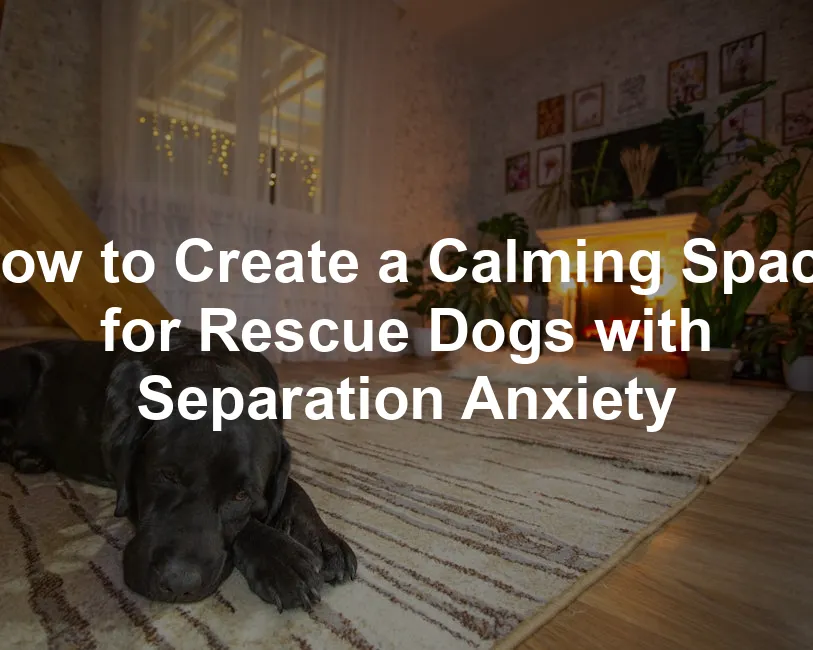Introduction
Creating a soothing sanctuary for your rescue dog with separation anxiety isn’t just a luxury—it’s a necessity. After all, these lovable companions have often endured tough pasts, making them more prone to anxiety when left alone. In this guide, we’ll explore how to transform your home into a calming oasis tailored specifically for your furry friend.
Choosing the right location is crucial. Think about spots that are cozy, quiet, and far from household chaos. Dogs thrive in environments where they feel safe and secure. You want to create a space that feels like a warm hug, not a cold cage.
Now, let’s stock this sanctuary with comforting items! Familiar scents, favorite toys, and cozy blankets can work wonders. These small touches provide a sense of familiarity that calms anxious minds. Consider adding a PetFusion Ultimate Dog Bed to provide the ultimate comfort for your pup!
We will also discuss incorporating tools and techniques to help your pup find their zen. Items like white noise machines and calming pheromones can turn your home into a fortress of tranquility. The Marpac Dohm Classic White Noise Machine is a stellar choice for drowning out those pesky sounds that might spook your pup.
Establishing a routine can help your dog understand that you will return. Routines create predictability, easing their anxiety.
So, let’s explore how to turn that anxious tail into a wagging one! Together, we can ensure your rescue pup feels safe, secure, and at ease every time you leave.

Summary
This article outlines essential strategies for creating a calming space for rescue dogs suffering from separation anxiety. With a focus on understanding canine anxiety, the article aims to empower pet owners to take actionable steps toward alleviating their dog’s distress. Key points include:
- Understanding Separation Anxiety: Recognizing symptoms and triggers of separation anxiety in rescue dogs.
- Creating a Safe Space: Designating a specific area in your home that is cozy, quiet, and accessible for your dog.
- Stocking the Sanctuary: Using familiar items, toys, and comforting scents to create a positive environment.
- Incorporating Tools and Techniques: Utilizing calming aids like white noise machines, pheromone diffusers, and interactive toys.
- Establishing Routines: Developing a predictable schedule to help your dog adjust to your departures and arrivals.
- Professional Help and Resources: Knowing when to seek help from veterinarians or animal behaviorists for severe cases.
By implementing these strategies, you can significantly reduce your dog’s anxiety and improve their overall quality of life. Curious about how to create the ideal environment for your rescue pup? Read on for detailed insights and practical tips!
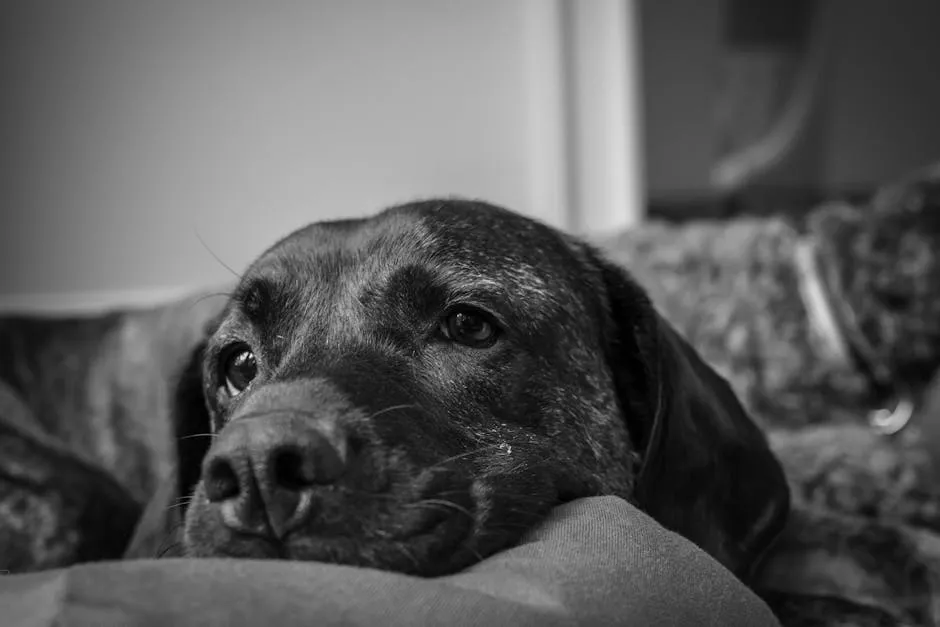
Understanding Separation Anxiety
What is Separation Anxiety?
Separation anxiety is a common behavioral disorder in dogs. It occurs when dogs experience extreme stress upon being left alone. This distress can manifest in various ways, impacting both the dog and the owner.
Anxious dogs may bark incessantly, chew on furniture, or even try to escape. These behaviors often arise from a strong attachment to their owners. When left alone, dogs without proper coping mechanisms struggle to adjust.
Rescue dogs are particularly susceptible to this condition. Many have faced trauma or instability in their previous lives. They may have missed out on crucial socialization, leading to heightened anxiety when alone. Recognizing separation anxiety in your furry friend is the first step toward helping them feel secure.

Signs of Separation Anxiety
Identifying the symptoms of separation anxiety is crucial for effective management. Here’s a detailed list of common signs:
- Vocalizations: Excessive barking, howling, or whining when left alone.
- Destructive Behavior: Chewing on furniture, tearing up pillows, or digging.
- Inappropriate Elimination: Urinating or defecating indoors, even if house-trained.
- Pacing: Repetitive walking in circles or back and forth when you prepare to leave.
- Restlessness: Signs of anxiety like panting, drooling, or trembling.
- Attempts to Escape: Scratching at doors, windows, or gates to find you.
- Clinginess: Following you around the house and showing distress when you leave.
These behaviors can vary in intensity. Some dogs may exhibit mild signs, while others might show severe distress. It’s essential to monitor your dog’s behavior closely to determine the best approach for addressing their anxiety.

Causes of Separation Anxiety
Understanding the causes behind separation anxiety can help in tailoring a solution for your dog. Here are some common factors that contribute to this condition in rescue dogs:
- Past Trauma: Many rescue dogs have experienced abandonment, abuse, or neglect. Such traumas can lead to lasting anxiety.
- Lack of Socialization: Dogs that haven’t been socialized properly may struggle to cope with being alone. They may not have learned how to self-soothe when left unattended.
- Changes in Environment: Moving to a new home or changes in the family structure can trigger anxiety. Dogs thrive on routine, and disruptions can cause stress.
- Previous Separation Anxiety: Dogs that had anxiety issues before adoption may continue to struggle with separation. This history can complicate their adjustment to a new environment.
Recognizing these causes can help you approach your dog’s separation anxiety with compassion and understanding. By creating a safe and calming environment, you can support your rescue dog on their journey to feeling secure when left alone.

Creating a Safe Space
Choosing the Right Location
Finding the right spot in your home for your dog’s safe space is vital. Look for areas that are quiet, comfortable, and away from household hustle. The goal is to create a retreat where your dog can feel secure. A cozy corner in your living room or a quiet spot in your bedroom can work well.
If you prefer using a crate, make it inviting. Keep the crate in a low-traffic area, allowing your dog to retreat there when they feel anxious. Make sure the space is well-ventilated and not too hot or cold.
Consider using a baby gate to block off a peaceful room, creating a secure haven for your dog. This area should be a haven, free from distractions and noise.

Stocking the Sanctuary
Once you’ve chosen the perfect location, it’s time to stock the space with comforting items. Start with cozy blankets and soft bedding for warmth and security. Add a variety of toys, particularly ones that engage your dog’s senses. The Furhaven Orthopedic Pet Bed is a fantastic choice to ensure your dog has a supportive and comfy place to rest.
Personal items, like an old t-shirt, can provide comfort through your scent. Familiar smells can help reduce anxiety. Consider including puzzle toys filled with treats to keep your dog mentally stimulated while you’re away.
Ensure the area has fresh water and maybe a special treat or two. This will create positive associations with the space, encouraging your dog to feel safe and comfortable.
Creating a calming sanctuary for your rescue dog is essential. By thoughtfully choosing a location and stocking it with comforting items, you can significantly reduce your dog’s anxiety and improve their overall well-being.
For more information on creating a safe space for your dog, check out the article on best practices for creating a safe space for pregnant dogs and puppies.
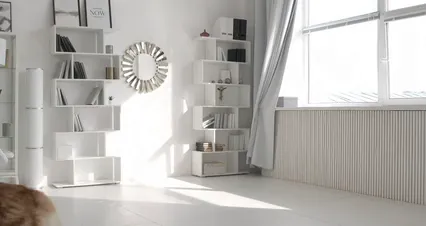
Tools and Techniques for Calmness
Calming Aids
Creating a serene environment for your rescue dog is essential. Calming aids can help ease anxiety and promote relaxation. Here’s a look at some popular products:
- Pheromone Diffusers: These mimic calming hormones present in a mother dog’s milk. They can be particularly effective. Brands like Adaptil offer diffusers to help soothe anxious pups.
- Calming Wraps: Similar to a snug hug, these wraps provide gentle pressure that helps reduce stress. The ThunderShirt is a favorite among dog owners for its effectiveness in minimizing anxiety.
- Interactive Toys: Keeping your dog engaged is key! Puzzle toys, such as the Kong Wobbler Treat Dispensing Dog Toy, can distract them from their worries. Stuff them with treats to make separation more enjoyable.
- Natural Supplements: Consider calming chews with ingredients like chamomile or L-theanine. Products like ZamiPet Calm Chews for Dogs can be beneficial for anxious dogs.
- White Noise Machines: These can mask disruptive sounds, making your dog feel more secure. Just like humans, dogs often find comfort in consistent background noise.
Experiment with these products to see what works best for your furry friend. Every dog is unique, and finding the right combination can make a world of difference.
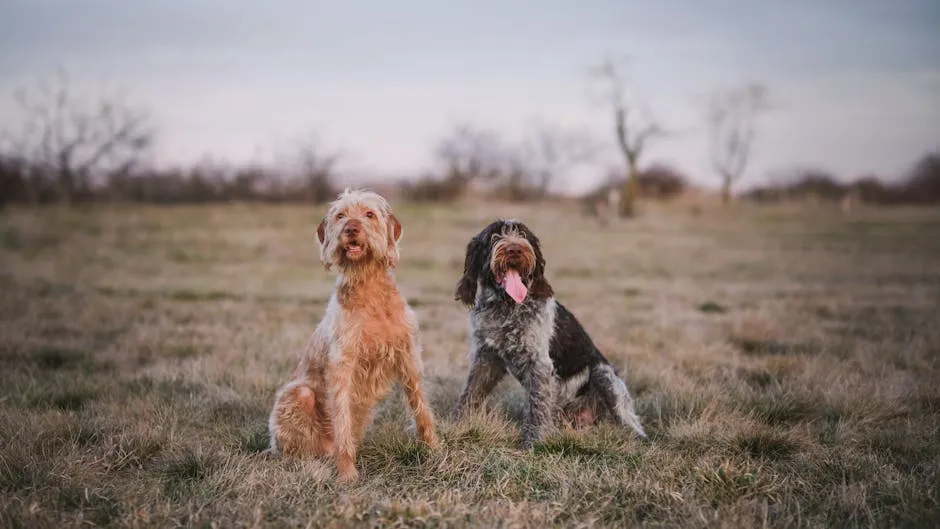
Establishing Routine
Just like humans, dogs thrive on routine. A consistent schedule for meals, walks, and departures fosters a sense of security. Here’s how to establish a calming routine:
- Set Meal Times: Feed your dog at the same times each day. This predictability helps them feel more secure in their environment.
- Regular Walks: Daily walks not only provide exercise but also mental stimulation. Incorporate playtime before you leave. A tired pup is often a calm one.
- Departure Cues: Practice low-key exits. Avoid over-dramatizing goodbye routines. Instead, calmly tell your dog you’ll be back. Use phrases like “Be good” to reinforce that you’ll return.
- Gradual Absences: Start with short separations. Leave for just a few minutes, gradually increasing the time as your dog becomes more comfortable.
- Consistent Reunions: Keep greetings calm and brief. This helps avoid anxiety during arrivals and departures.
By implementing a routine, your dog will begin to understand that being alone is a temporary and safe situation.
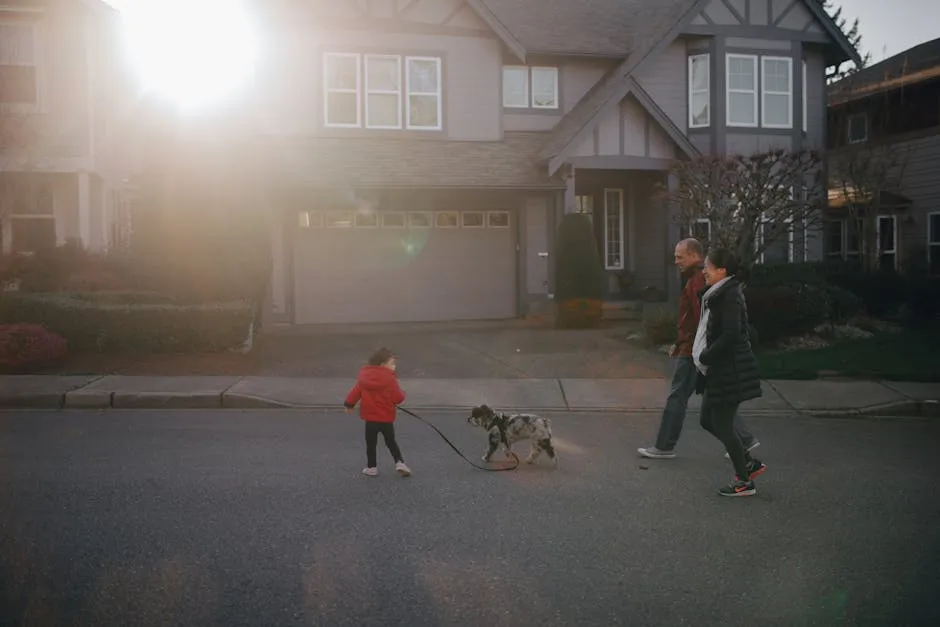
Training Techniques
Positive reinforcement and gradual desensitization are powerful tools for helping your dog conquer separation anxiety. Here are some effective training techniques:
- Desensitization: Start by identifying triggers. If your dog reacts to you picking up keys, practice randomizing your departure routine. Pick up your keys and sit down instead of leaving. This helps break the association between those cues and your departure.
- Positive Reinforcement: Reward calm behavior with treats and praise. If your dog remains calm when you leave, shower them with affection upon your return.
- Practice Commands: Teach commands like “stay” and “place.” Gradually increase the time you leave your dog in a designated spot. This builds their confidence in being alone.
- Engage in Short Training Sessions: Incorporate brief training exercises throughout the day. Teaching tricks or commands can mentally stimulate your dog, making them less anxious.
- Use a Crate or Safe Space: If your dog enjoys their crate, introduce it slowly. Make it a cozy retreat filled with their favorite toys. Always ensure they associate it with positive experiences.
By employing these techniques, you help your dog learn to be comfortable being alone, transforming anxiety into calmness over time.
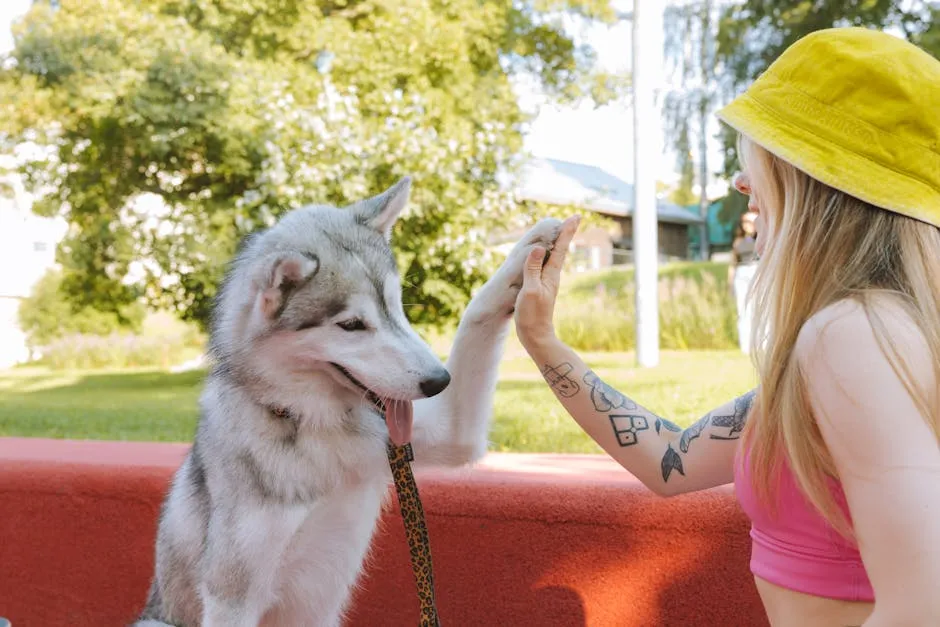
When to Seek Professional Help
Recognizing Severe Cases
When managing separation anxiety in rescue dogs, knowing when to seek professional help is crucial. Some signs indicate that your furry friend might need a little extra support. If your dog exhibits excessive vocalization, such as constant barking or howling, it’s time to take note. Destructive behaviors, like chewing furniture or scratching at doors, can signal distress. If your dog is experiencing accidents indoors despite being house-trained, it indicates a heightened level of anxiety.
Other signs include severe attempts to escape, which can lead to injury. If you notice your pup pacing or displaying signs of extreme restlessness, it may be time to consult a professional. A veterinarian can assess their health and rule out any underlying issues. Additionally, certified animal behaviorists specialize in addressing behavioral problems and can provide tailored strategies for your pup’s unique situation.
Don’t hesitate to seek help; it’s a proactive step toward ensuring your dog’s well-being. Professionals can guide you through an effective treatment plan that combines training, behavior modification, and, if necessary, medication. Your dog deserves a life filled with comfort and happiness, so don’t shy away from getting the assistance they need.
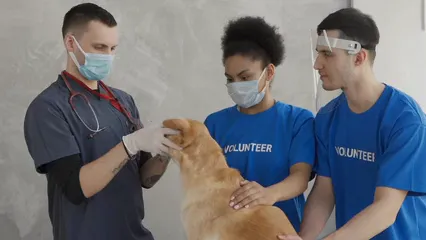
Resources for Dog Owners
As a dog owner navigating the challenges of separation anxiety, accessing helpful resources can make all the difference. Numerous online platforms provide insights, support groups, and educational material tailored to anxious pups. Websites like the American Kennel Club (AKC) and ASPCA offer valuable information on managing separation anxiety and finding appropriate training techniques.
Books such as “The Dog’s Way” by John and Amy D. Gibbons and “I’ll Be Home Soon!” by Patricia McConnell provide practical strategies and expert advice for dog owners. These reads can empower you with the knowledge necessary to help your dog thrive.
Additionally, consider joining local or online support groups where pet owners share experiences and solutions. Platforms like Facebook and Reddit host communities dedicated to helping fellow dog owners navigate similar challenges.
Engaging with these resources not only provides practical tips but also fosters a sense of community. Remember, you’re not alone in this journey. Many dog owners have faced similar hurdles and can offer invaluable support and encouragement.
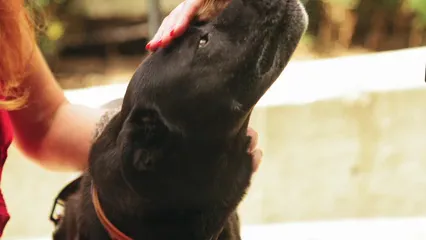
FAQs
What is the best way to introduce my dog to their new safe space?
Start by making the introduction gradual. Place your dog’s bed or crate in the designated area. Allow them to explore freely without pressure. Use treats and toys to encourage them to enter the space. Make it a positive experience by spending time with your dog in the area. Gradually leave them alone for short periods while you’re nearby. Reinforce calm behavior with praise and treats. Over time, they’ll associate the space with comfort and safety. Patience is key—don’t rush the process!
How long does it take for a dog to adjust to being alone?
Adjustment timelines can vary widely. Some dogs may adapt in a matter of weeks, while others could take months. Factors influencing this include the dog’s past experiences, age, and temperament. Consistency in your routine helps a lot! Regular practice with short absences can ease the transition. Monitoring their progress and adjusting your approach based on their reactions is essential. Remember, every dog is unique, and patience is crucial for helping them feel secure.
Can I crate train a dog with separation anxiety?
Crate training can be beneficial but has pros and cons. On the plus side, a crate can provide a safe, enclosed space for your dog. It can help prevent destructive behaviors when you’re away. However, if your dog has a strong aversion to being confined, it could worsen their anxiety. Gradual acclimation is key. Make the crate inviting with soft bedding and familiar toys. Use positive reinforcement to create positive associations. Always prioritize your dog’s comfort above all.
What are some signs that my dog’s separation anxiety is improving?
Look for positive changes in behavior. If your dog becomes more relaxed when you prepare to leave, that’s a great sign! Other indicators include less vocalization, reduced destructive behavior, and a calmer demeanor upon your return. If they are able to stay in their safe space without distress, that’s a big win! It’s important to celebrate these small victories. Each step toward improvement indicates progress in managing their anxiety and building their confidence.
Should I consider medication for my dog’s separation anxiety?
Medication can be an option for severe cases, but it should complement behavioral training. Always consult your veterinarian before starting any treatment. They can evaluate your dog’s specific situation and recommend appropriate options. There are also natural alternatives, such as calming supplements or pheromone diffusers, that might be helpful. Combining medication with training and environmental adjustments can yield the best results. Your goal is to create a supportive environment for your furry friend.

Conclusion
Creating a calming space for your rescue dog with separation anxiety is a vital step in ensuring their comfort and happiness. By understanding their needs and implementing strategies to alleviate their anxiety, you can foster a loving and secure environment. Remember that patience and consistency are key—your furry friend may take time to adjust, but the effort will be well worth it in the end. Celebrate each small victory and take pride in your role as their trusted companion.
The journey to help your rescue dog overcome separation anxiety is rewarding. With the right strategies and support, you’ll see improvements over time. Cherish the moments when your dog begins to relax and feel secure in their safe space. Your bond will grow stronger as they learn to trust you and their new home.
Keep in mind that every dog is unique. What works for one pup may not work for another. Stay flexible and willing to adapt your approach as needed. By remaining committed, you’re setting the stage for a happier, more confident dog. Embrace the journey, and together, you and your furry friend can conquer the challenges of separation anxiety!
Please let us know what you think about our content by leaving a comment down below!
Thank you for reading till here 🙂
All images from Pexels

